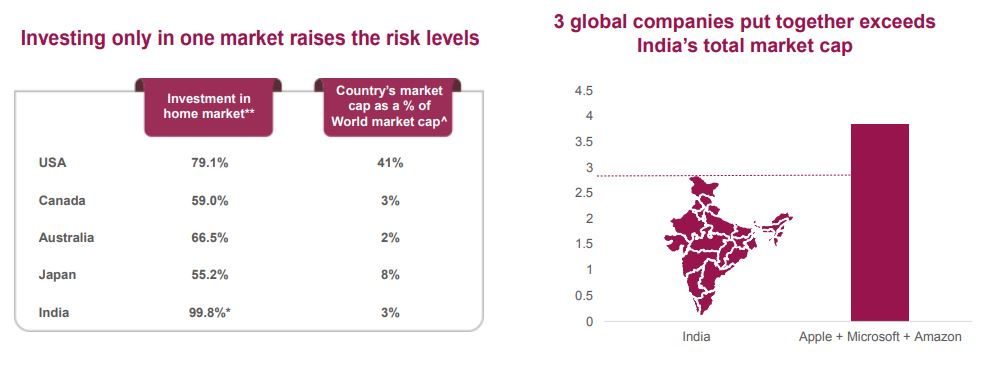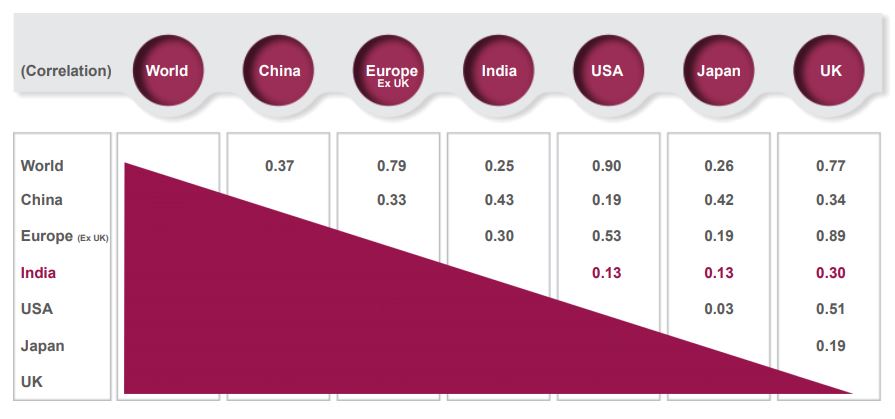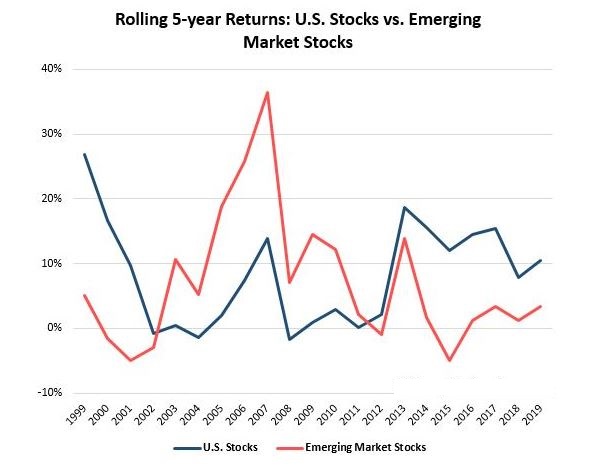Where we live has a major impact on our daily lives—from our favorite foods, to which IPL team we support, we tend to prefer what’s nearby. It’s no different with our investments.
As we can see below, India accounts for only 3% of the entire global market capitalization. However, the average Indian investor allocates 99% of their portfolio to Indian equities, demonstrating a clear preference for national investments.
Most of us Indian equity investors generally choose Indian equities but this national preference may stop us from reaping the benefits of prospects in first-world and other third-world markets.

Let evaluate some common fallacies we all have about investing domestically versus globally.
Fallacy 1: The Indian market tends to deliver higher returns.
Let us have a look at the table below.

As apparent in the table above, the winner keeps changing. It’s not possible for India to always be the top performer.
So there is the need to diversify; in different asset classes and in different markets. As with many other things, there is safety in numbers.
Fallacy 2: Currency fluctuation is basically detrimental to returns.
Quite the contrary, the appreciation of the American dollar boosts a fund’s performance in Indian rupee terms.
There are mainly two factors that propel your profits in any overseas equity investment. Firstly, the risks relating to the specific market you choose to invest in and secondly, currency volatility. The first is the case regardless of which market you invest in, including the Indian market. But currency instability only adds another level to this risk. Luckily for us the Indian rupee has historically declined against the US dollar so international equity investment has mostly benefited us.

When the Indian rupee declines, the value of assets in overseas investments grows and vice versa.
Since India has traditionally been a high inflation nation, in the big picture, its currency tends to decrease in value in comparison to other key currencies.
Fallacy 3: Returns are the only thing that matter when investing.
They are certainly a major consideration. But there are other features to reflect on as well.
The whole is stronger than the sum total of its parts. Including global equities in a portfolio not only increases expected returns but very importantly, decreases volatility risk.
Regardless of how cautious you are, you can neither foresee nor influence the future. A global pandemic, a natural disaster, a walkout at a supplier’s plant, a surprise hi-tech advancement by competition, or a government ordered lockdown; any of these can cost a company crores of Rupees. You may not be in on the inside story when you bought a stock of what appeared to be a well managed company and be in for a surprise when it’s value plummets due to serious internal problems.
Hence the importance of diversification; by industry, by risk and by country. If you search worldwide, you will find better bargains. Even if Indian markets have delivered higher returns, these have come at a higher volatility.
What is Volatility? Why does it matter?
Volatility is the typical variation of returns around its average. It is a decent gauge of how much the market fluctuates upwards and downwards in the specified period (preferably short term).
Many long-term investors are not concerned with volatility but it is significant because if you are invested in a very volatile market, a market drop just might induce you to sell early.

One approach cannot deliver reliable returns over all periods. This is why diversification is always an essential part of any long term investment plan. This can be accomplished by acquiring assets which are less correlated to one another.
Fallacy 4: Returns from all markets are related
During the global financial crisis of 2008, the Indian stock market lost 56.8% but the US stock market witnessed a fall of less than half of that: 24.1%. In the next year, the Indian market rose by 91.5% but the US market appreciated by just 18.7%. Markets don’t move in tandem.
When constructing a portfolio, acquiring un-correlated assets assists in lowering volatility down poor performance periods.
Correlation is a measure of the common connection (or lack of) between two variables. It essentially shows whether the two variables move together or move in opposite directions or have no link with each other.
A correlation coefficient of 1 indicates a completely direct association in which the two variables move together, a correlation of -1 indicates a totally inverse connection and a correlation of 0 indicates no relationship between the two variables.
Diverse markets have varying risk levels with developed markets having lower risk. For example, the S&P 500 (in rupee terms) has a low level of correlation with India’s Nifty 50 Index, just 0.13. Hence, an investor whose portfolio is mostly invested in Indian markets will derive diversification benefits by investing in the S&P 500 Index Fund.

Moderation is key
There are fads and trends in investments as well. It could be mid cap stocks. It could be gold. Maybe Bitcoin. Or a Pharma theme. In 2020, it was international mutual funds.
Recent outperformance always attracts attention and investor money. To figure out, you just need to look at how quickly the size of the best performing mutual fund grows.
But the fact remains, in investing, no one thing works repeatedly.
As you can see, emerging market stocks outperformed US stocks from 2002 to 2013. It was only from 2014 to 2019 that US stocks have delivered higher returns.
In the 2000’s, looking at the rolling five-year returns for both US stocks and emerging market stocks, we can clearly see that the two took turns outperforming each other.

From 1999 till 2002, it was an excellent time to hold U.S. stocks. Then, from 2002 till 2012, it was a wonderful time to hold emerging market stocks. And from 2012 till date, it has been more beneficial to hold U.S. stocks again.
Access to the Best in the World
International funds offer investors numerous opportunities in new age industries like ecommerce, social media, electric vehicles, cyber security and cloud computing among others. Amazon, Netflix, Facebook, Twitter, Louis Vuitton, Walmart and Tesla have been recent outperformers. By investing in International funds you can get exposure to these world class stocks.
The Way Forward
- Become a risk conscious investor. Construct a portfolio that will not only achieve your goals but also manage risks.
- Today, you can diversify not only across asset categories but also across geographies. You can invest a portion of your portfolio internationally to be able to hedge your exposure to global events.
- Your portfolio should maintain your international purchasing power. Indians are now international consumers; ensure your portfolio increases in line with international costs.
- Avoid market timing and invest long term. Investing in foreign assets involves market price risk and currency risk making it even more difficult to time the market. Currency can be volatile in the short term so don’t let short term fluctuations impact your decisions.
International Mutual Fund Taxation
International mutual funds invest majorly in equity of international companies. Since they do not primarily invest in domestic equities, they are not classified as equity funds. Hence, for tax purposes, these funds are treated as debt funds. Therefore, the rules for LTCG and STCG for debt funds apply to these funds too. So, short-term gains from holdings up to three years are added to the taxpayer’s income and taxed according to the tax slab one falls in. In the case of long-term capital gains, on holdings beyond three years are taxed at 20% after adjusting for inflation with indexation benefits.
This give domestic funds like PPFAS Flexi Cap, Kotak Pioneer Fund, etc, that invest around 30% of their corpus in US stocks an advantage. These schemes are treated as equity schemes for taxation as they invest 65% of their corpus in Indian equities. That means, if you sell your investments after a year, you need to pay only 10% long-term capital gains tax on your returns. Even the short-term capital gains tax is only 15%.
To conclude, neither you nor I can forecast whether the US stock market or emerging markets will be outperforming for the near future. It makes sense but both will take turns outperforming in different years. So a prudent choice might be to invest in both markets.
This may not lead to much higher performance but it can lead to lower volatility since the two markets take turns outperforming each other. This is the point of diversification. By investing in different kinds of assets, one earns similar returns are holding one but with less volatility.
“Don’t look for the needle in the haystack. Just buy the haystack!”
John C. Bogle



